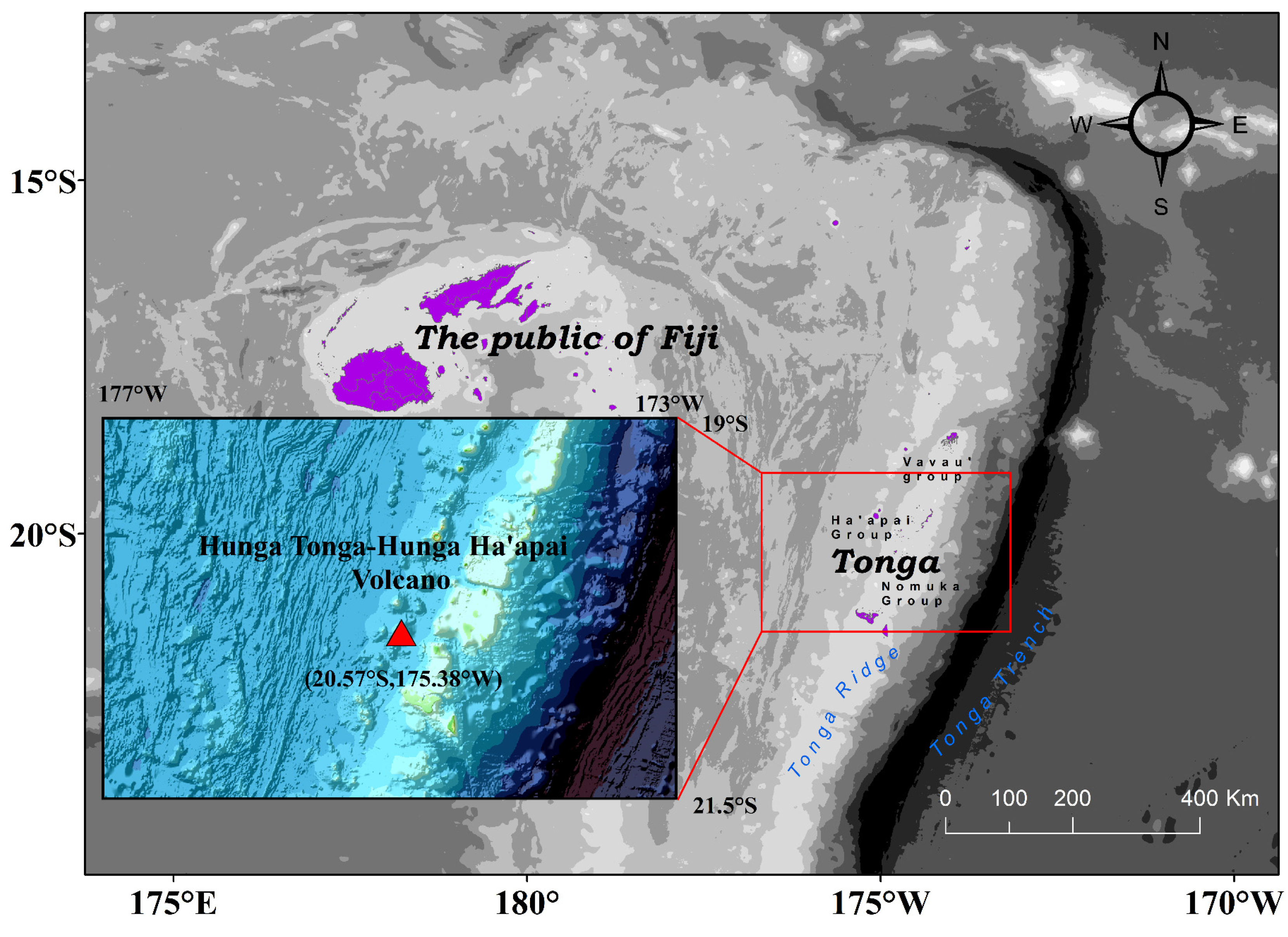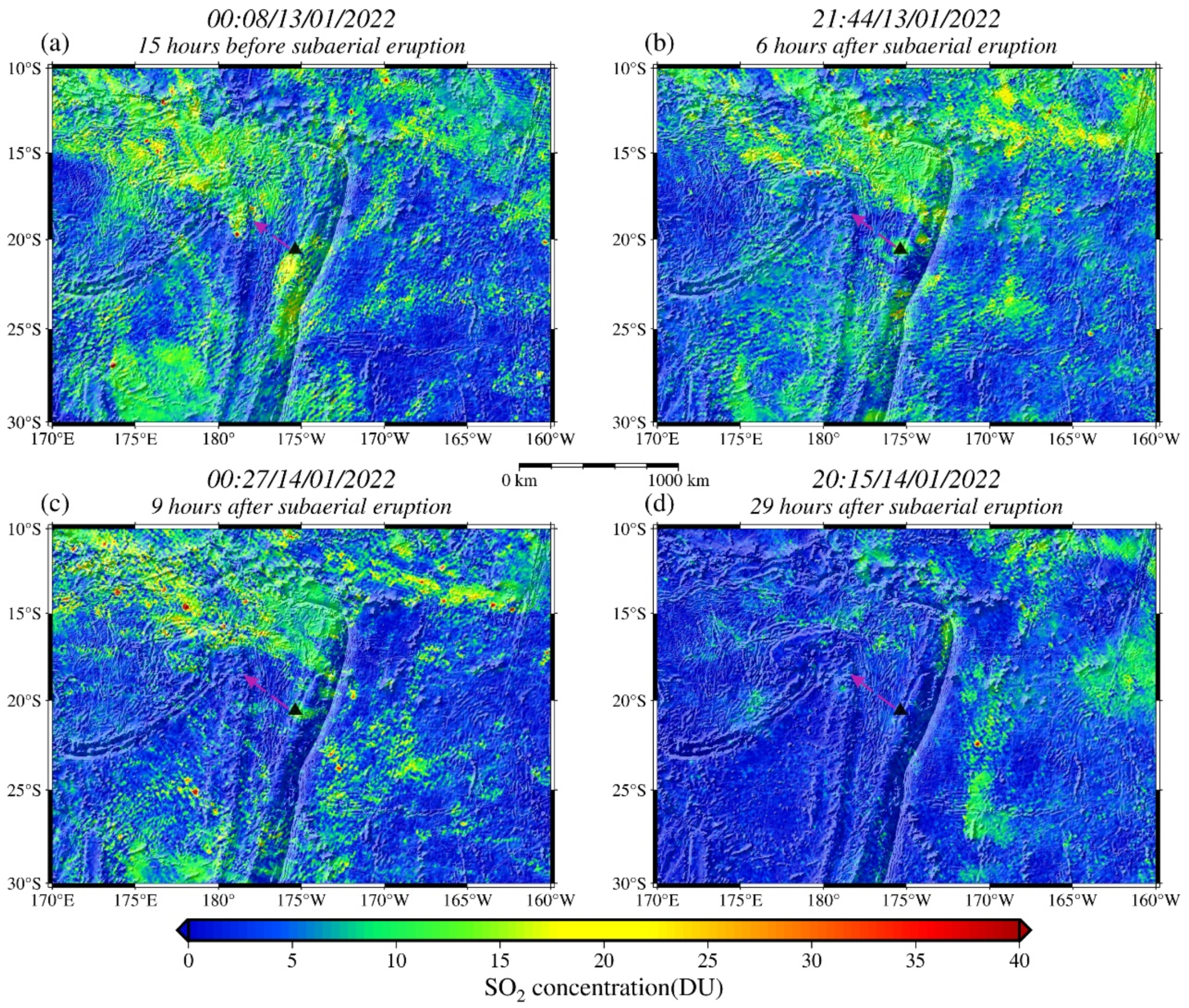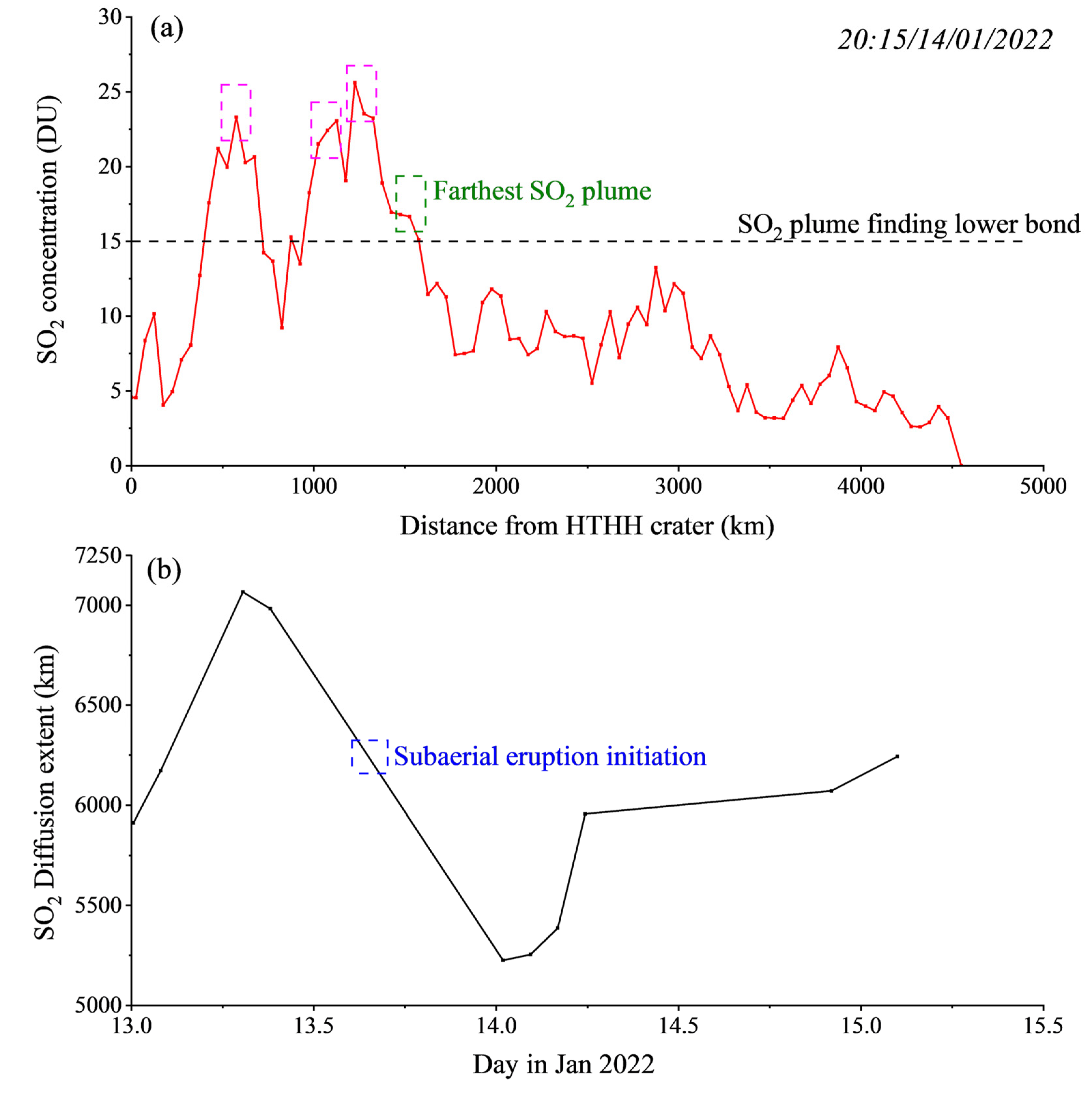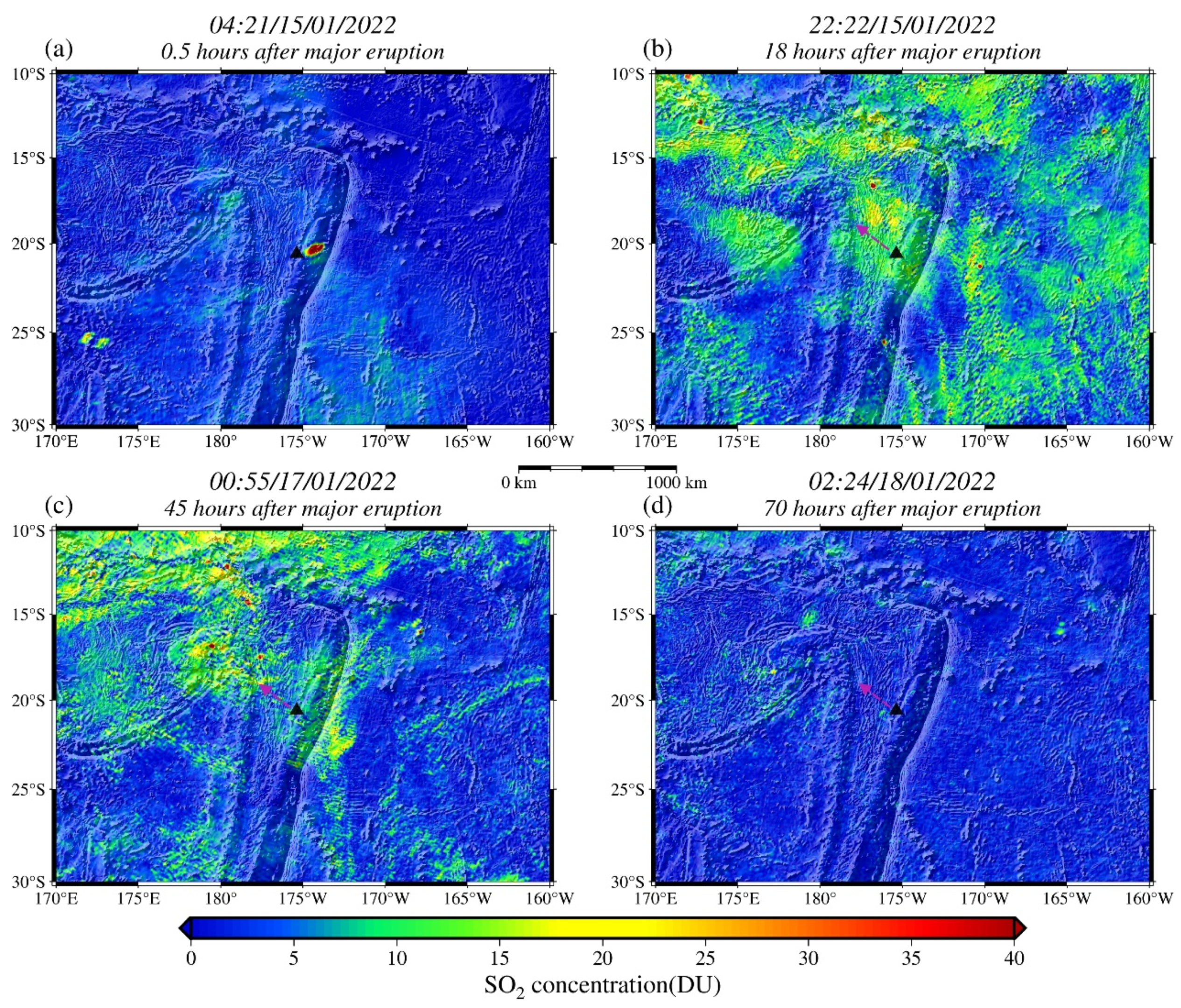SO2 Diffusion Features of the 2022 Hunga Tonga–Hunga Ha’apai Volcanic Eruptions from DSCOVR/EPIC Observations
Abstract
1. Introduction
2. Data and Methods
2.1. DSCOVR EPIC SO2 Data
2.2. Negative Values and Sub-Solar-Point Effect Corrections
2.3. SO2 Plume Identification
3. Results
3.1. SO2 Diffusion Features of HTHH Subaerial Eruption Beginning at 15:20 on 13 January 2022 UTC
3.2. SO2 Diffusion Features of HTHH Major Eruption Initiating at 04:00 on 15 Jan 2022 UTC
4. Discussion
5. Conclusions
Author Contributions
Funding
Institutional Review Board Statement
Informed Consent Statement
Data Availability Statement
Acknowledgments
Conflicts of Interest
References
- Chim, M.M.; Aubry, T.J.; Abraham, N.L.; Marshall, L.; Mulcahy, J.; Walton, J.; Schmidt, A. Climate Projections Very Likely Underestimate Future Volcanic Forcing and Its Climatic Effects. Geophys. Res. Lett. 2023, 50, e2023GL103743. [Google Scholar] [CrossRef]
- Pope, F.D.; Braesicke, P.; Grainger, R.G.; Kalberer, M.; Watson, I.M.; Davidson, P.J.; Cox, R.A. Stratospheric aerosol particles and solar-radiation management. Nat. Clim. Change 2012, 2, 713–719. [Google Scholar] [CrossRef]
- Aubry, T.J.; Staunton-Sykes, J.; Marshall, L.R.; Haywood, J.; Abraham, N.L.; Schmidt, A. Climate change modulates the stratospheric volcanic sulfate aerosol lifecycle and radiative forcing from tropical eruptions. Nat. Commun. 2021, 12, 4708. [Google Scholar] [CrossRef] [PubMed]
- Marshall, L.R.; Maters, E.C.; Schmidt, A.; Timmreck, C.; Robock, A.; Toohey, M. Volcanic effects on climate: Recent advances and future avenues. Bull. Volcanol. 2022, 84, 54. [Google Scholar] [CrossRef]
- Clare, M.A.; Yeo, I.A.; Watson, S.; Wysoczanski, R.; Seabrook, S.; Mackay, K.; Hunt, J.E.; Lane, E.; Talling, P.J.; Pope, E.; et al. Fast and destructive density currents created by ocean-entering volcanic eruptions. Science 2023, 381, 1085–1092. [Google Scholar] [CrossRef] [PubMed]
- Gupta, A.K.; Bennartz, R.; Fauria, K.E.; Mittal, T. Eruption chronology of the December 2021 to January 2022 Hunga Tonga-Hunga Ha’apai eruption sequence. Commun. Earth Environ. 2022, 3, 314. [Google Scholar] [CrossRef]
- Xu, J.; Li, D.; Bai, Z.; Tao, M.; Bian, J. Large Amounts of Water Vapor Were Injected into the Stratosphere by the Hunga Tonga–Hunga Ha’apai Volcano Eruption. Atmosphere 2022, 13, 912. [Google Scholar] [CrossRef]
- Barone, B.; Letelier, R.M.; Rubin, K.H.; Karl, D.M. Satellite Detection of a Massive Phytoplankton Bloom Following the 2022 Submarine Eruption of the Hunga Tonga-Hunga Ha’apai Volcano. Geophys. Res. Lett. 2022, 49, e2022GL099293. [Google Scholar] [CrossRef]
- Shikwambana, L.; Sivakumar, V.; Xongo, K. Tracking the Transport of SO2 and Sulphate Aerosols from the Tonga Volcanic Eruption to South Africa. Atmosphere 2023, 14, 1556. [Google Scholar] [CrossRef]
- Boichu, M.; Grandin, R.; Blarel, L.; Torres, B.; Derimian, Y.; Goloub, P.; Brogniez, C.; Chiapello, I.; Dubovik, O.; Mathurin, T.; et al. Growth and Global Persistence of Stratospheric Sulfate Aerosols From the 2022 Hunga Tonga–Hunga Ha’apai Volcanic Eruption. J. Geophys. Res. Atmos. 2023, 128, e2023JD039010. [Google Scholar] [CrossRef]
- Li, R.; Lei, J.; Kusche, J.; Dang, T.; Huang, F.; Luan, X.; Zhang, S.-R.; Yan, M.; Yang, Z.; Liu, F.; et al. Large-Scale Disturbances in the Upper Thermosphere Induced by the 2022 Tonga Volcanic Eruption. Geophys. Res. Lett. 2023, 50, e2022GL102265. [Google Scholar] [CrossRef]
- Basha, G.; Ratnam, M.V.; Kumar, A.H.; Jiang, J.H.; Babu, S.R.; Kishore, P. Impact of Hunga Tonga-Hunga Ha’apai Volcanic Eruption on Stratospheric Water Vapour, Temperature, and Ozone. Remote Sens. 2023, 15, 3602. [Google Scholar] [CrossRef]
- Jiang, N.; Gao, Z.; Xu, Y.; Xu, T.; Guo, A.; Wu, Y.; Li, S. Response Analysis on Multi-Parameters in the 2022 Tonga Volcanic Eruption Using Satellite-Ground Combined Data. J. Geophys. Res. Atmos. 2023, 128, e2023JD038839. [Google Scholar] [CrossRef]
- Pandey, P.C. Highlighting the role of earth observation Sentinel5P TROPOMI in monitoring volcanic eruptions: A report on Hunga Tonga, a Submarine Volcano. Remote Sens. Lett. 2022, 13, 912–923. [Google Scholar] [CrossRef]
- Carn, S.A.; Krotkov, N.A.; Fisher, B.L.; Li, C. Out of the blue: Volcanic SO2 emissions during the 2021–2022 eruptions of Hunga Tonga—Hunga Ha’apai (Tonga). Front. Earth Sci. 2022, 10, 1–18. [Google Scholar] [CrossRef]
- Matoza, R.S.; Fee, D.; Assink, J.D.; Iezzi, A.M.; Green, D.N.; Kim, K.; Toney, L.; Lecocq, T.; Krishnamoorthy, S.; Lalande, J.-M.; et al. Atmospheric waves and global seismoacoustic observations of the January 2022 Hunga eruption, Tonga. Science 2022, 377, 95–100. [Google Scholar] [CrossRef] [PubMed]
- Smith, G.L.; Wong, T.; Bush, K.A. Time-Sampling Errors of Earth Radiation From Satellites: Theory for Outgoing Longwave Radiation. IEEE Trans. Geosci. Remote Sens. 2015, 53, 1656–1665. [Google Scholar] [CrossRef]
- Smith, G.L.; Wong, T. Time-Sampling Errors of Earth Radiation From Satellites: Theory for Monthly Mean Albedo. IEEE Trans. Geosci. Remote Sens. 2016, 54, 3107–3115. [Google Scholar] [CrossRef]
- Burt, J.; Smith, B. Deep Space Climate Observatory: The DSCOVR mission. In Proceedings of the 2012 IEEE Aerospace Conference, Big Sky, MT, USA, 3–10 March 2012; pp. 1–13. [Google Scholar]
- Marshak, A.; Herman, J.; Adam, S.; Karin, B.; Carn, S.; Cede, A.; Geogdzhayev, I.; Huang, D.; Huang, L.-K.; Knyazikhin, Y.; et al. Earth Observations from DSCOVR EPIC Instrument. Bull. Am. Meteorol. Soc. 2018, 99, 1829–1850. [Google Scholar] [CrossRef] [PubMed]
- Ahn, C.; Torres, O.; Jethva, H.; Tiruchirapalli, R.; Huang, L.-K. Evaluation of Aerosol Properties Observed by DSCOVR/EPIC Instrument From the Earth-Sun Lagrange 1 Orbit. J. Geophys. Res. Atmos. 2021, 126, e2020JD033651. [Google Scholar] [CrossRef]
- Efremenko, D.S.; Loyola, R.D.G.; Hedelt, P.; Spurr, R.J.D. Volcanic SO2 plume height retrieval from UV sensors using a full-physics inverse learning machine algorithm. Int. J. Remote Sens. 2017, 38, 1–27. [Google Scholar] [CrossRef]
- Esse, B.; Burton, M.; Hayer, C.; Pfeffer, M.A.; Barsotti, S.; Theys, N.; Barnie, T.; Titos, M. Satellite derived SO2 emissions from the relatively low-intensity, effusive 2021 eruption of Fagradalsfjall, Iceland. Earth Planet. Sci. Lett. 2023, 619, 118325. [Google Scholar] [CrossRef]
- Huang, X.; Yang, K. Algorithm theoretical basis for ozone and sulfur dioxide retrievals from DSCOVR EPIC. Atmos. Meas. Tech. 2022, 15, 5877–5915. [Google Scholar] [CrossRef]
- Govender, P.; Sivakumar, V. Application of k-means and hierarchical clustering techniques for analysis of air pollution: A review (1980–2019). Atmos. Pollut. Res. 2020, 11, 40–56. [Google Scholar] [CrossRef]
- Funk, C.C.; Theiler, J.; Roberts, D.A.; Borel, C.C. Clustering to improve matched filter detection of weak gas plumes in hyperspectral thermal imagery. IEEE Trans. Geosci. Remote Sens. 2001, 39, 1410–1420. [Google Scholar] [CrossRef]







Disclaimer/Publisher’s Note: The statements, opinions and data contained in all publications are solely those of the individual author(s) and contributor(s) and not of MDPI and/or the editor(s). MDPI and/or the editor(s) disclaim responsibility for any injury to people or property resulting from any ideas, methods, instructions or products referred to in the content. |
© 2024 by the authors. Licensee MDPI, Basel, Switzerland. This article is an open access article distributed under the terms and conditions of the Creative Commons Attribution (CC BY) license (https://creativecommons.org/licenses/by/4.0/).
Share and Cite
Huang, Y.; Duan, W. SO2 Diffusion Features of the 2022 Hunga Tonga–Hunga Ha’apai Volcanic Eruptions from DSCOVR/EPIC Observations. Atmosphere 2024, 15, 1164. https://doi.org/10.3390/atmos15101164
Huang Y, Duan W. SO2 Diffusion Features of the 2022 Hunga Tonga–Hunga Ha’apai Volcanic Eruptions from DSCOVR/EPIC Observations. Atmosphere. 2024; 15(10):1164. https://doi.org/10.3390/atmos15101164
Chicago/Turabian StyleHuang, Yi, and Wentao Duan. 2024. "SO2 Diffusion Features of the 2022 Hunga Tonga–Hunga Ha’apai Volcanic Eruptions from DSCOVR/EPIC Observations" Atmosphere 15, no. 10: 1164. https://doi.org/10.3390/atmos15101164
APA StyleHuang, Y., & Duan, W. (2024). SO2 Diffusion Features of the 2022 Hunga Tonga–Hunga Ha’apai Volcanic Eruptions from DSCOVR/EPIC Observations. Atmosphere, 15(10), 1164. https://doi.org/10.3390/atmos15101164





